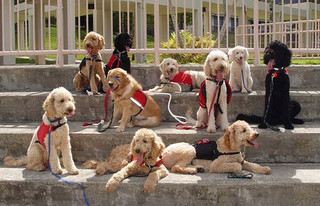 I want to start this article out by defining what a service dog is as there is no end of confusion. A service dog is a dog who has been trained to aid someone with a disability. That’s it. The disability could be blindness, deafness, PTSD, diabetes, epilepsy, or other.
I want to start this article out by defining what a service dog is as there is no end of confusion. A service dog is a dog who has been trained to aid someone with a disability. That’s it. The disability could be blindness, deafness, PTSD, diabetes, epilepsy, or other.
Before ever talking about service dog training I always first start out by talking about service dog etiquette as there is a great deal of confusion out there.
Service Dog Etiquette
When you are in public and you see a service dog the rule of thumb is ‘don’t do it or say it unless you would do or say the same thing about a wheelchair.
What do I mean?
If you see someone in a wheelchair would you ever ask to go pet the wheelchair or otherwise touch it? Probably not.
If you see someone in a wheelchair would you ever go ask that stranger why they are in a wheelchair? I know I wouldn’t. It’s none of my business and that person in the wheelchair probably has no desire to discuss their wheelchair with me.
Would you stare at someone in a wheelchair? Nope.
Would you make comments as the person in a wheelchair passes by like, ‘Look kids! Isn’t that cool that the person is in a wheelchair!’? I doubt it.
If you wouldn’t do or say those things to someone in a wheelchair then don’t do it to someone who is accompanied by a service dog.
That person with a service dog is dealing with a disability. They probably don’t want to talk to you about their disability. They’re just trying to buy groceries, get on their plane, or handle some other type of business. They don’t need to be interrupted every 2 minutes by someone who wants to touch, pet, or talk about their service dog.
Not only that, their dog is trained for a certain task. That task becomes much more difficult if people are constantly wanting to touch, talk to, or coo at the dog.
Finding a Service Dog
Now, if you are a person with a disability that is looking to do some service dog training or get a trained dog here are the main things to consider:
- Temperament
You’ve got to have a dog with a good temperament. At my company we get many requests for help in training their current dog to be a service dog. Unfortunately, many of these dogs are highly anxious or aggressive. Now, through training, you can solve a lot of aggression or anxiety issues. Even so, you want to start with a dog that already has a sound temperament. - Obedience Training
One of the most important tasks for ANY service dog is to have high levels of obedience. Your dog is going to be going into highly distracting areas in public with lots of other people, sights, sounds, dogs, shopping carts, cars, and more. Your dog has to navigate that world while never breaking the heel position, staying when told, coming when called, etc. - Specialized training
There are some types of specialized training that some people can do on their own. For example, training your dog to pick up dropped objects, flick a light switch or other specialized training commands can often be accomplished on your own.
For more specialized tasks like leading around a blind person or detecting seizures of low blood sugar it is likely you’ll need help from professionals.
To me there are few things more amazing than the bond that occurs between a person and a dog when that dog happily goes about their duties of being a service dog.
Image credit: Beverly & Pack








3 Responses to “Service Dog Training”
Hi, I appreciate it very much for your write up, I think it is really thoughtful and if truth be told, an eye opener, I honestly love the ideas that you bring into blogging, I’ve got a pitbull puppy and I have being seeking for products like this one. Cheers.
I am an owner trainer, and I wanted to thank you for your comparison of a service dog to a wheelchair. It would be nice if more people understood that. I am also freely telling you that I am visually impaired, and I have trained two guide dogs for myself. That being said it is always advisable to seek out information if not a professional trainer.
You’re welcome. Hopefully more folks can learn proper service dog etiquette.